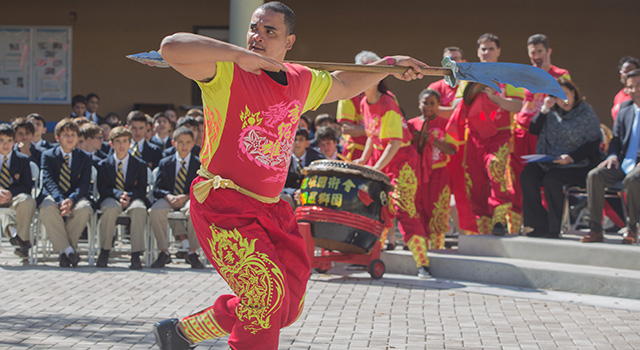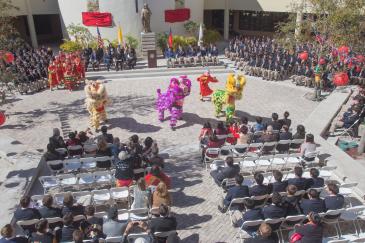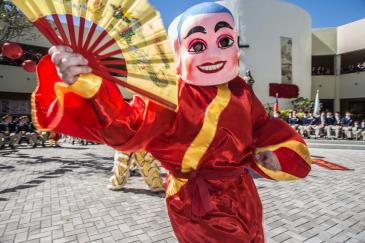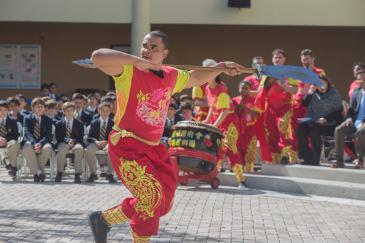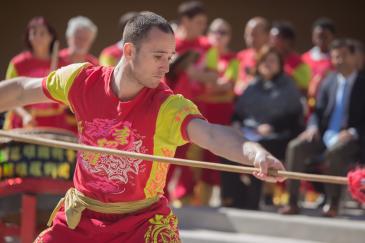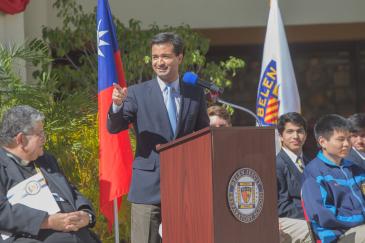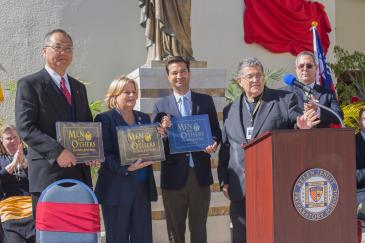By Priscilla A. Greear - Florida Catholic
Photography: MARLENE QUARONI | FC
MIAMI | Some Catholic high schools in South Florida are looking eastward for the 21st century. Among those reaching beyond the Great Wall of China:
• Chaminade-Madonna College Preparatory School has 34 students enrolled from China this school year.
• Archbishop Edward A. McCarthy High School hosted 11 Chinese students in January 2014 and took five students to visit their new friends in China last July.
• Carrollton School of the Sacred Heart started its Mandarin program —from kindergarten through high school — 11 years ago and also has an exchange with a Sacred Heart school in Taipei through which it now hosts two Taiwanese students for eight weeks.
• St. Thomas University has enrolled over 100 students from China and other Asian nations, and last summer began a new immersion program where it welcomed over 20 high school students from Taiwan to prepare them to later attend college in the United States.
The latest Chinese program to bloom across the Miami archdiocese belongs to Belen Jesuit Preparatory School. It now offers a class in Mandarin, plans a summer trip to Taiwan, Thailand and Hong Kong, and has launched a Taiwanese cultural exchange program.
The 6-12 boys’ school just held a Chinese New Year celebration to recognize its new exchange program with the Jesuit St. Ignatius High School in Taiwan. The event drew 20 Chinese officials, Congressional Representatives Illeana Ros-Lehtinen and Carlos Curbelo, and Philip Wang, director general of the Taipei Economic and Cultural Office in Miami.
Wang presented the school with a silk replica of the “One Hundred Horses” 1728 masterpiece by Jesuit Italian-Chinese painter Brother Giuseppe Castiglione.
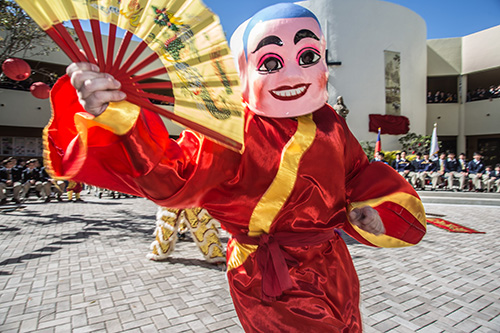
Photographer: MARLENE QUARONI | FC
Roman Newman wears a Buddha face while performing a Lion Dance at Belen Jesuit Prep. He is a member of Lee Koon Hung Kung Fu Association and Lion Dance team.
Last June, Belen took 36 students on a trip to China as part of its expanded Overseas Study Program. They visited the Bund Waterfront in Shanghai, Jade Buddha Temple and the Forbidden City in Beijing, and even took a calligraphy lesson in Xian. They also met with Belen Jesuit alumni, including a recent graduate who completed his freshman year of New York University in Shanghai.
“The importance of our relationship with China is not from within the school but from the outside, in the sense that we noticed that (there were a) number of graduates who had studied in China or who have moved to work in China,” said Jesuit Father Pedro Suarez, Belen’s president.
“And it’s not only a Belen phenomenon but also a phenomenon all over the United States,” he continued. “It’s going to be a world with more interactions with other parts of the world, with greater diversity, greater commerce…This is a new world.”
On the China trip, Belen students learned about Jesuit missionary history, starting with the 16th century scientist Father Matteo Ricci, whose observatory they visited in Beijing. When they sported their Ricci T-shirts, many Chinese commented on the Jesuit pioneer who learned Chinese language and culture and fostered progress and understanding.
“They thought that he was a great man of culture who went to China and was the first one who opened China to the western world,” said Father Suarez. “In view of this longtime relationship of the Jesuits in China, we thought that it was very appropriate that we would pursue this line of getting close to the people of China.”
The visitors also experienced progress firsthand in the communist nation’s relations to the Vatican, as Father Suarez celebrated Mass at the cathedral in Beijing.
“The pastor came out and said, ‘We are in communion with the Vatican and our archbishop was appointed by Pope Francis and has been accepted by the Chinese Patriotic Church,’” he recalled. “At last the Patriotic Church of China has accepted the Catholic archbishop — that’s a big step forward. At that point I almost cried.”
Following up on that experience, Belen launched its Introduction to Chinese Language and Culture class at the start of this school year. In November, Father Suarez, along with Dean of Discipline Charles Cleveland and Director of Admissions Brian Wentzel, visited St. Ignatius in Taipei, where they found a match made in heaven for a cultural exchange.
The two schools share the Jesuit Christian ideals and tradition of academic excellence as well as a similar history: Belen started in Cuba in 1854 and relocated to Miami after Fidel Castro came to power in 1961. St. Ignatius started in China in 1850 and after the communist takeover relocated in 1963 to the island of Taiwan.
Through the new exchange, Belen welcomed five students from St. Ignatius for about two weeks in February and plans to send five to Taiwan over Easter.
Click here for related story: They're speaking Mandarin
“Taiwan seems to be far more (suited) for the Christian experience,” because of its democracy, human rights and religious freedom, said Cleveland, who founded the Overseas Study Program. “I think we’d like to explore that relationship further now that it is solidified.”
Belen’s Matteo Ricci China Club was founded in 2013 by a student, Miguel Zaldivar. Then came the China trip and language class, where the original plan was to have students just speak Mandarin.
“Low and behold this fine teacher from Taiwan has students writing paragraphs in written Mandarin which is beyond what we could imagine or think,” said Cleveland. “That is why I see this whole thing as a blessing of God. The Bible says that God can do far beyond what you can ever ask or think. Everyone who walks into that classroom and watches that teacher teach is absolutely amazed... After the accolades from the students this year…now there is a lot more interest.”
Before the Chinese assembly, sophomore Mandarin student Oscar Berlanga spoke enthusiastically about the class and pulled out a cell phone picture of a Chinese message he painted for wealth and fortune for the event. He’s one of the pioneer 25 pupils — and seemingly undaunted by the roughly 5,000 Chinese characters.
“The class is very fun. Some days it’s easier, some days are more challenging, but it’s being taught in a way that’s pretty cool because we’re not only learning how to speak but we’re being taught how to read and write in Chinese characters,” said Oscar, who knows Spanish and plans to pursue international relations.
For his part, Tung-Kai Chen, a senior at St. Ignatius, said he took this “great opportunity” to experience American life. He was warmly welcomed by Belen families upon arrival at the school, complete with balloons, signs and pastelitos followed by a traditional Cuban dinner.
It was “the first time we arrived at the school and people are cheering,” he said. “They are very friendly to us.”
He has enjoyed snorkeling in the Keys, visiting the Everglades, fishing and other activities with his host school family. He said he liked attending classes, explaining that he found the American teaching style to be more interactive. He has also fielded plenty of language questions and explained cultural differences between China and Taiwan.
“We think we are independent but it is the same culture but is a little bit different from China,” Tung-Kai said.
Cleveland was unsure how the Belen students would engage but feels they rose to the occasion.
“We got outside of ourselves and this is an incredible Christian experience in the sense that we welcomed people from the other side of the world, a different culture from our own — and no remuneration financially,” he said. “The more exposure students have to other cultures that are Christian the more they get an insight into God… This is a wonderful testament to the body of Christ.”
Oscar said he is excited to attend the Asia trip this summer and participate in the exchange program next year.
“Our school is always like, ‘Oh, we’re super Latin,’ and we totally ignore that there are other cultures out there, so it’s very cool that we’ve gone so far outside our comfort zone. Yet these kids, I can identify with them a lot even though they are as far East as it goes for us,” he said. “They are very kind and very welcoming and they always want to know more about our culture. Here in the U.S. we’re very, ‘Oh, our culture is the best,’ but over there they always want to learn more about the world. And I think that is something we can learn as Americans.”
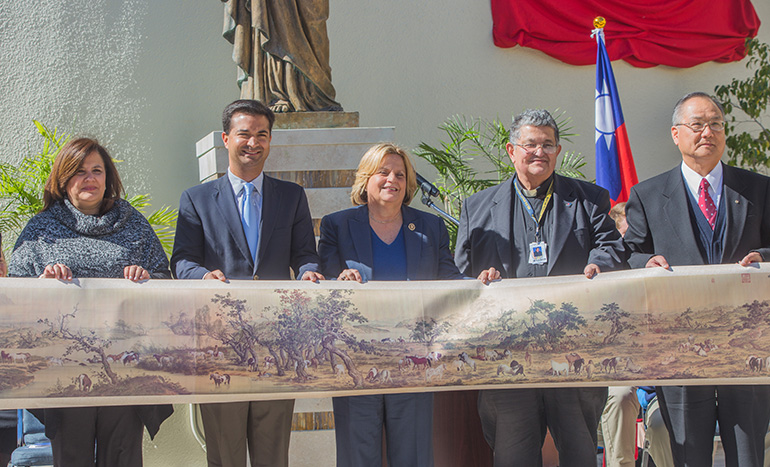
Photographer: MARLENE QUARONI | FC
Holding a silk replica of the masterpiece "One hundred horses," painted in 1728 by the Jesuit painter and Brother Giuseppe Castiglione, from left: Maria Cristina Reyes-Garcia, Belen Jesuit Prep principal; U.S. Rep. Carlos Curbelo, Belen class of 1998; U.S. Rep. Ileana Ros-Lehtinen; Jesuit Father Pedro Suarez, Belen president; and Philip Wang, director general of the Taipei Economic and Cultural Office in Miami, who presented the school with the replica.
